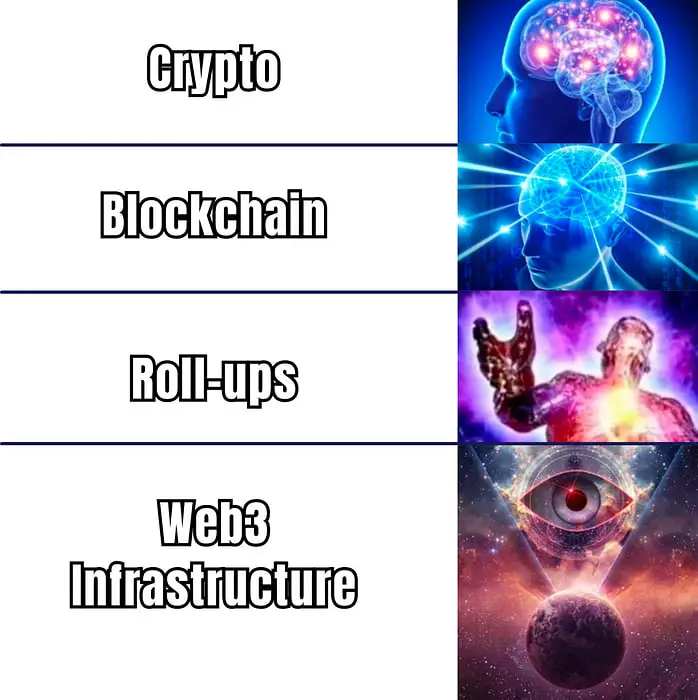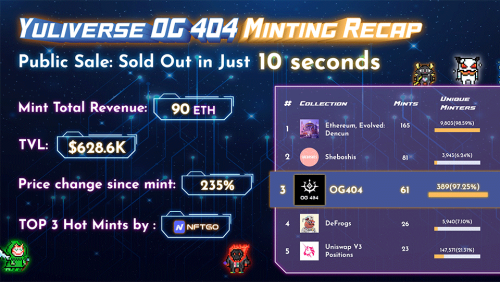Talk to any crypto venture capital firm nowadays, and they will mention their focus on blockchain infrastructure. When you dig deeper into the specifics of what they are interested in, you often hear an expansive elaboration on applications, rollups, and Layer 1 (L1) solutions. It almost seems like everything and anything can be categorised under infrastructure.
Acknowledging the lack of clear distinction and classification in this field is important. Unlike traditional industries, Web3 is an emerging space that lacks well-established and ossified infrastructure pillars. In contrast, innovation within the Web3 realm constantly pushes boundaries and challenges existing notions of infrastructure.
Given the immense potential of Web3, investing in proper infrastructure that can capture the market shows significant lucrative potential. While it is very difficult to foresee radical innovations, having a point of reference is still helpful when examining the market and technical innovation. To understand how innovation connects technology to the market, read our 2023 crypto investment thesis.
For infrastructure investment, each fund has a different approach. Notable ones like Multicoin Capital and Jump Crypto have written their own articles about the Web3 infrastructure. The same is relevant for DWF Ventures.
Blockchain Architecture and Frameworks
Currently, the Web3 space broadly categorises the blockchain stack into three primary layers:
- Application layer.
- Middleware layer.
- Blockchain layer.
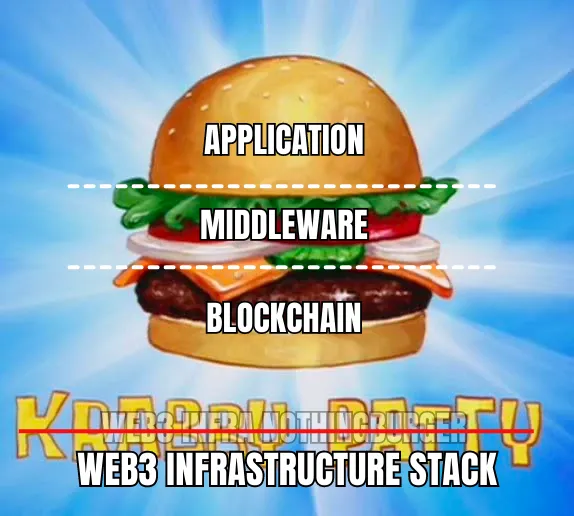
Given this broad categorisation, it is difficult to identify the positioning of individual projects. To address this, our team will examine existing technical blockchain standards to gain insights into the underlying architecture. This will serve as a foundation for conceptualising the proprietary DWF Ventures's Web3 infrastructure stack.
Similar to internet standards, there are multiple national and international standards for reference, explored by several prominent meta-studies, for example, the paper “Comparing Blockchain Standards and Recommendations”.
For initial analysis, we will look into the World Economic Forum’s 2020 Global Standards Mapping Initiative whitepaper, which compared two popular blockchain standards suggested by the Institute of Electrical and Electronics Engineers (IEEE) and the International Telecommunication Union (ITU).
The IEEE’s Standard for Blockchain Architecture
The first overview of blockchain architecture, or distributed ledger technology, is based on the IEEE's 42010 systems and software engineering standards, which are part of the International Organization for Standardization (ISO).

This overview presents five main architectural domains:
- Platform. Hardware technology, including chipsets, devices, nodes, and the network.
- Data. Recording and storage of information within the blockchain.
- Process. Consensus mechanism for ledger formation.
- Services. Information sharing and calling, including services like DNS, Oracles, and APIs.
- Application. User interface for interacting with the blockchain.
The ITU’s Blockchain Architecture Framework
The standard by the International Telecommunication Union (ITU) identifies five functional components of the blockchain:
- Core layer. Consensus, network and infrastructure, hardware, node management, and storage.
- Service layer. Manages information, data, protocols, and governance.
- Application service: Covers DApp development tools, accounting, authentication, data privacy, and operation and maintenance.
- DLT applications. Refers to user-facing front-end applications.
- External services. Includes off-chain extensions for operations and resource management.
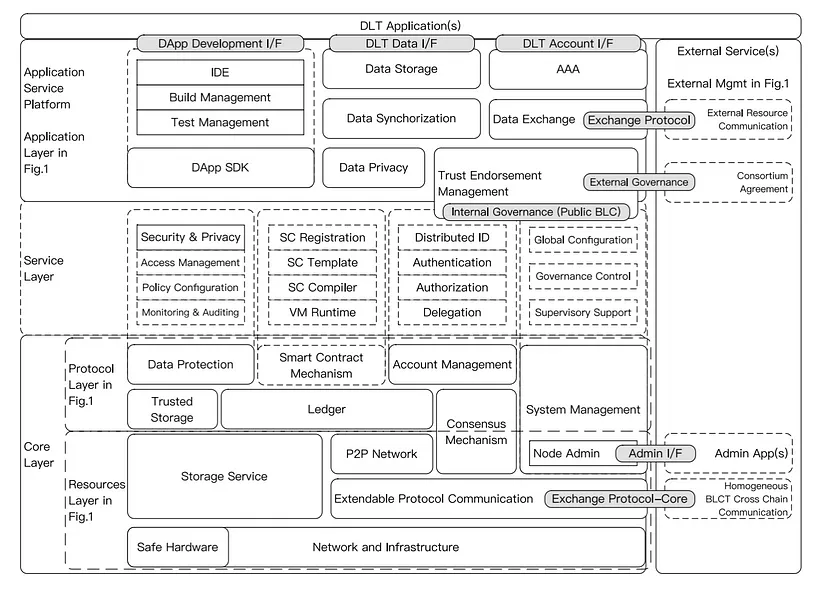
Both standards define blockchain architecture in terms of five layers. However, the ITU standard clearly distinguishes interoperability and off-chain aspects within the external services component, while the IEEE focuses more on the individual blockchain framework. For better comparison, below is our table to align the ITU and IEEE standards layers together.
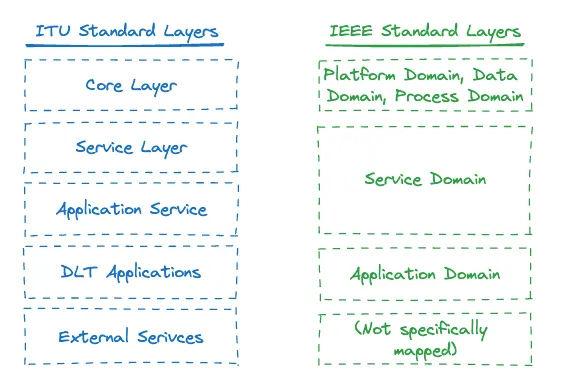
An Alternative Approach to Blockchain Architecture
Having reviewed the first two frameworks, we also analysed a paper by Bokolo published in 2023, which covers the blockchain framework of implementation in virtual enterprises or decentralised autonomous organisations (DAOs). Here is the outline of the framework offered by the author:
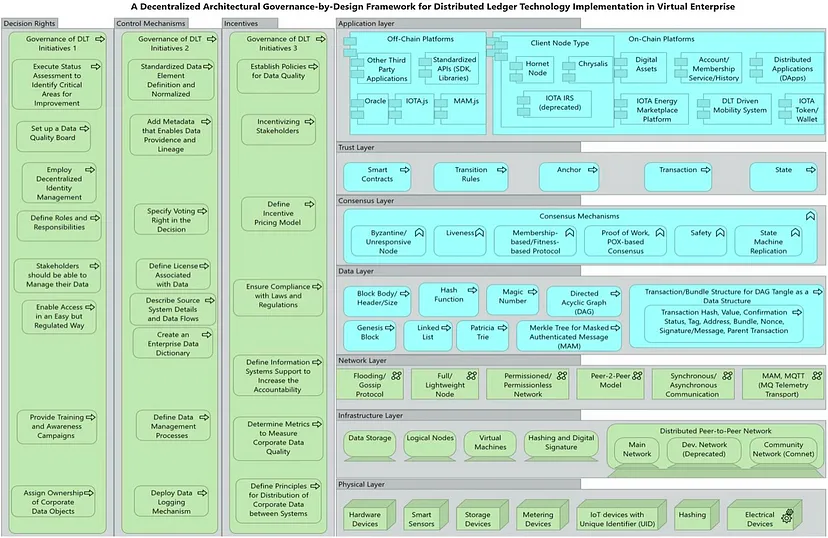
In total, there are ten components: the first seven are blockchain architectural elements, while the last three focus on governance:
- Application layer. Integrates traditional applications with embedded blockchain for communication.
- Trust layer. Ensures security and stability with contract scripts and smart contracts.
- Consensus layer. Manages transaction validation and ledger consistency.
- Data layer. Stores data using structures like Merkle trees and linked lists.
- Network layer. Facilitates communication and information exchange among nodes.
- Infrastructure layer. Manages permissions and access controls with physical and virtual nodes.
- Physical layer. Includes hardware devices requiring middleware for integration.
- Decision rights. Specifies roles and power distribution within the platform.
- Control mechanisms. Establishes rules for collaboration and consensus among stakeholders.
- Incentives. Motivates actors’ involvement and innovative outputs, including pecuniary (financial) and non-pecuniary (reputation, privileges) incentives.
IEEE vs ITU vs Bokolo’s Blockchain Architecture Frameworks
In contrast with IEEE and ITU, Bokolo’s framework introduces additional layers such as Governance Dimensions. These play a crucial role in the design and operation of blockchain platforms, facilitating decentralised and secure transactions and enabling collaboration among diverse actors.
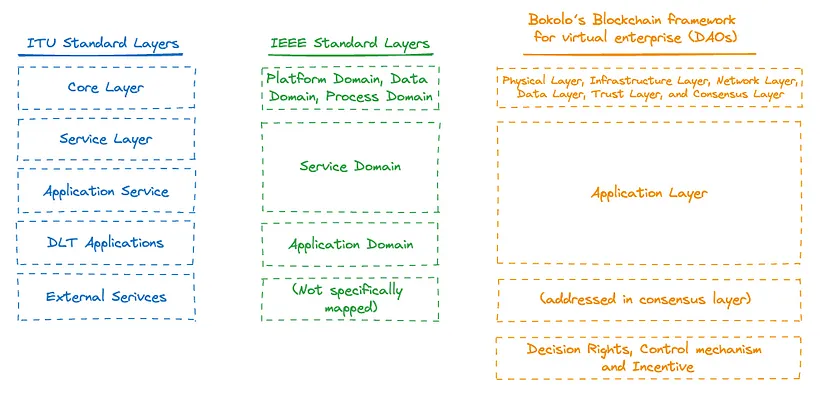
A notable distinction among the standards lies in the emphasis placed on either the blockchain technology stack or the application stack: ITU focuses more on applications and other services, while IEEE and Bokolo underline the blockchain technology.
Web3 Infrastructure Through the Lens of DWF Ventures
After comparing the three blockchain frameworks and standards available in the academic field, we built a framework as a guiding mechanism to understand the positioning of different crypto projects.
For our infrastructure framework, we consider three main points:
- Focus on the application stack versus the blockchain stack, emphasising specific layers.
- Limiting middleware definition to software, excluding hardware.
- The significance of the governance layer, and its inclusion in the framework as seen in the Bokolo’s study.
Based on these considerations, we have developed our proprietary Web3 infrastructure stack overview:
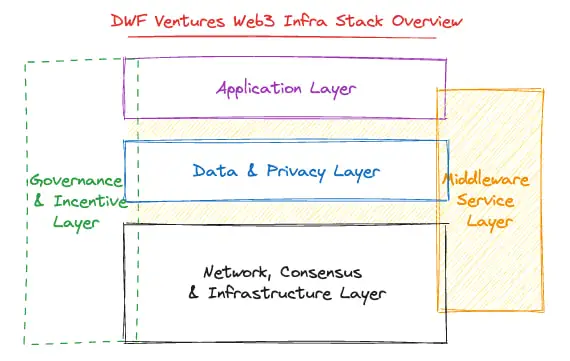
We strive for maintaining a balanced approach by emphasising equal importance to both the application and blockchain stack.
From the chart above, we can say that we focus on four main layers and one conditional layer:
- Application layer;
- Data and privacy layer;
- Network, consensus and infrastructure layer;
- Middleware service layer;
- (Conditional) Governance and incentives layer.
The main distinction is that we define data and privacy as a separate layer, as we believe in its significance. As the Web3 community expands with more users and services, the importance of the data and privacy layer will only keep growing.
For middleware, we are focusing on software applications as we believe they should remain rooted in their traditional use case within internet infrastructure, serving as services across/within different architecture layers.
Lastly, we recognize governance and incentives as vital components of the stack, given the decentralised nature of Web3. However, we acknowledge that the need for this layer may vary across scenarios, hence its representation with a dotted line denotes its conditional requirement in the stack.
The layers of DWF Ventures Web3 infrastructure stack can be further explained in the following diagram:
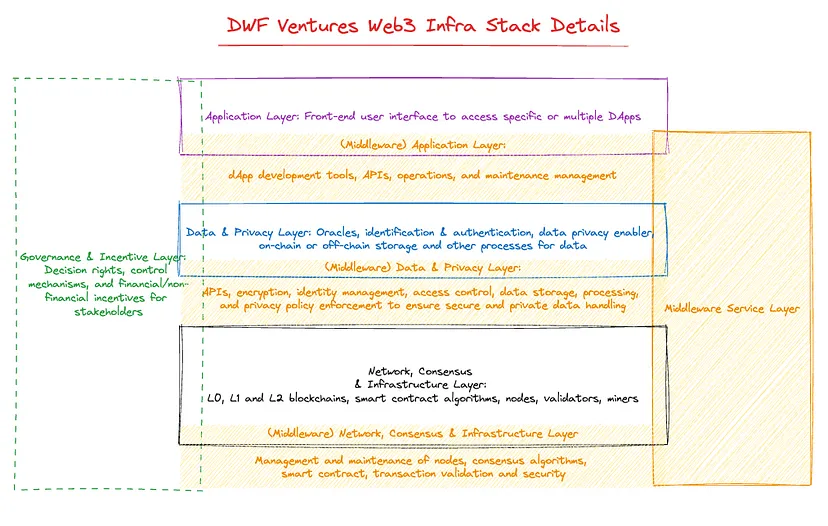
Conclusion
The development of our own Web3 infrastructure framework has provided DWF Ventures with valuable insights into understanding the positioning of various crypto projects. It allows us to assess projects more effectively and make informed decisions.
We are particularly interested in exploring middleware solutions and advancements in data and privacy within the network, consensus, and infrastructure layers. If you are looking for a crypto venture capital partner to build together, send your pitch via the form on the DWF Ventures’ page.
